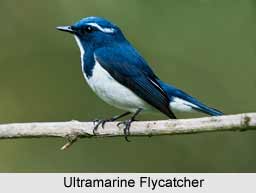 Ultramarine Flycatcher or White-Browed Blue Flycatcher is an Indian bird that bears a scientific name "Ficedula superciliaris" that breeds in the foothills in the Himalayan Mountain Range and the migration in the winter months to Southern India.
Ultramarine Flycatcher or White-Browed Blue Flycatcher is an Indian bird that bears a scientific name "Ficedula superciliaris" that breeds in the foothills in the Himalayan Mountain Range and the migration in the winter months to Southern India.
Breeding of Ultramarine Flycatcher
Ultramarine Flycatcher or White-Browed Blue Flycatcher is a small arboreal Old World Flycatcher in the ficedula family. Ultramarine Flycatcher or White-Browed Blue Flycatcher breeds in the foothills of the Himalayan Mountain Range and winters in southern part of India.
Concentration of Ultramarine Flycatcher
Ultramarine Flycatcher or White-Browed Blue Flycatcher are the common breeding visitor to the western Himalayan Mountain Range, from Jammu and Kashmir and Himachal Pradesh to Uttarakhand (western race), and intergrading within Nepal with the eastern race aestigma which continues in the eastern Himalayas through Bhutan to Arunachal Pradesh. Breeding between 2000-2700 m, occasionally as low as 1800 and as high as 3200 m. Also in the lower hills of Meghalaya and Nagaland, Khasi and Cachar hills, sometimes considered a third race; winter movements of this population is not known.
Habitat of Ultramarine Flycatcher
Ultramarine Flycatcher or White-Browed Blue Flycatcher usually stays in open, mixed forests of oak, rhododendron, pine, fir, etc., occasionally orchards.
Migration of Ultramarine Flycatcher
Ultramarine Flycatcher migrates in Central India from Delhi south to northern Maharashtra, Goa, northern Maharashtra, and eastward to Andhra Pradesh and Odisha.
Population of Ultramarine Flycatcher
Ultramarine Flycatcher or White-Browed Blue Flycatcher has the wintering populations in the eastern states, possibly from Nepal and Sikkim, are mixed: a good part of this population also have white supercilium and basal tail patches.
Structure of Ultramarine Flycatcher
Ultramarine Flycatcher or White-Browed Blue Flycatcher is somewhat smaller than a sparrow (ca. 10 cm) and with a stocky build. The male White-Browed Blue Flycatcher is deep blue above, sides of head and neck are deep blue, and a prominent white patch runs from centre of throat, through breast to belly. The amount of white on the brow and tail show clinical variation from West to East along the Himalayan foothills, which is sometimes taken to distinguish three races like, western race from the western Himalayas has a distinctive white supercilium and white bases to the outer tail feathers, eastern race (aestigma) from the eastern Himalayan Mountain Range lacks distinct white patches.
Population of Ultramarine Flycatcher
The population of Ultramarine Flycatcher from the south Assam hills sometimes designated a third race cleta that completely lack any supercilium.
Nests of Ultramarine Flycatcher
Ultramarine Flycatcher is of soft structure of fine moss with some strips of bark and fine grass, lined with hair and rootlets, place in holes or clefts in trees, at heights up to seven meters, or in a depression on a steep bank. Readily takes to nest boxes in hill station gardens.
Eggs of Ultramarine Flycatcher
Ultramarine Flycatcher lays 3 to 5 eggs. Usually 4 eggs are of olive greenish to dull stone-buff, densely freckled all over with reddish brown, or in another type, mostly around the large end, forming a cap. The average size of the eggs of Ultramarine flycatcher is 16 X 12.2 mm.



















